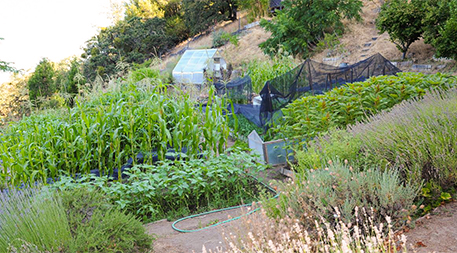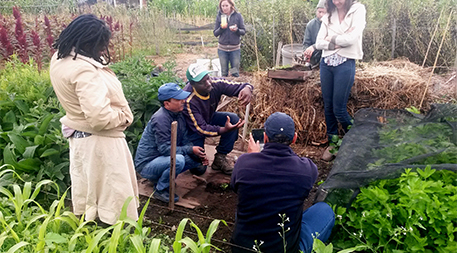Her face shaded by a wide-brimmed straw hat, Olawumi Benedict is cheerfully tending to her “little babies” — kale seedlings growing in shallow wooden flats until they’re hardy enough for transplantation into soil beds. Three miles over the hills on another small farm, Jonnes Mlegwah is double-digging the soil with a spading fork, preparing to plant potatoes. Both are Africans, but these mini-farms are 140 miles north of San Francisco in Mendocino County, better known for the harvesting of redwood trees and marijuana plants than kale and potatoes.
Benedict and Mlegwah are a long way from home, and the biointensive farming system they’re mastering is a long way from becoming the norm — in the U.S. or Africa. Still, millions of small-scale farmers, especially in Latin America and Africa, are turning to it because it’s low-cost and low-tech, and it produces far greater yields than conventional agriculture while using far less land and water.
Biointensive’s key components besides transplanting and double-digging are on-site composting, close plant spacing, use of seeds from plants that have been naturally pollinated and specific food-to-compost crop ratios. These methods are rarely practiced on large farms, where mechanization is more profitable, but they can be life-changing for the 90 percent of the world’s farmers who work 4 acres (2 hectares) or less by helping them to make the most of a given plot of land.
Biointensive farms use 50 to 75 percent less land and 94 to 99 percent less energy to produce a given amount of food than does conventional farming.Research shows that biointensive farms use 50 to 75 percent less land, 50 to 100 percent less fertilizer, 67 to 88 percent less water and 94 to 99 percent less energy to produce a given amount of food than does conventional farming. Perhaps most intriguingly, biointensive methods “grow” farmable soil — at a rate 60 times faster than occurs in nature — while traditional farming methods tend to deplete farmable soil through wind and water erosion.
Much of the credit for biointensive’s global impact goes toEcology Action, which has brought Benedict, Mlegwah and about 100 other interns and apprentices to California mini-farms for internships since 2001. Headed by organic gardening pioneer John Jeavons in 1971 and funded by foundations and donations, the nonprofit teaches biointensive farming at three Mendocino County locations to agriculture activists and researchers from around the world who conduct research and then go on to teach others.

Common Ground mini-farm, established in Medocino County, California, in 1982, serves as a global demonstration site for biointensive farming. Photo by Cynthia Raiser Jeavons/Ecology Action
Sitting at a pine-shaded picnic table overlooking the one-third-acre Ecology Action farm where Mlegwah works, the neatly bearded Jeavons, 74, sounds professorial while rattling off numbers. But there’s no hiding his passion for Earth-friendly farming or his concern for the world’s growing water scarcity and rapid disappearance of farmable land.
“The main criticism of biointensive is that it requires too much labor,” he says. “But it’s really more skill-based than labor-based — you work smarter, not harder. When you miniaturize agriculture, you don’t need as much land.”
Support for the methods have come from many quarters, including the Peace Corps, UNICEF and the 2010 U.N. Convention to Combat Desertification. Former U.S. Department of Agriculture Secretary Bob Bergland has called biointensive farming a potential way out for malnourished people worldwide.
“That would be a remarkable development in this world, and would do more to solve the problems of poverty, misery and hunger than anything else we’ve done,” Bergland says in Jeavons’ book How to Grow More Vegetables.
Learning and Growing
Each year, Ecology Action staff members choose up to eight individuals from outside the U.S. to participate in the internship program based on the food security needs of the interns’ native countries and the interns’ potential impact once they return home. Most have been from Latin America in past years, but biointensive has taken hold well enough there that 2016 interns are mostly from Africa. Interns attend one day of lectures and spend four nine-hour days per week learning on the farms. They stay from first planting in March to last harvest in November.
As they master biointensive techniques, each intern conducts experiments on a separate 300-square-foot (28 square-meter) plot — slightly larger than a bowling alley lane — with the research findings then used to advance biointensive farming knowledge. Benedict beams with pride as she describes her experiment: comparing the seed and biomass yields of millet when it’s spaced in a hexagonal pattern at intervals of 5, 7, 9 and 12 inches (13, 18, 23 and 30 centimeters). Upon returning home to Ghana she aims to open a biointensive farming center with her husband. Ecology Action staff are helping her pursue funding.
“The need is great because climate change has affected the rain pattern,” she says. “But farmers can get through famines by preparing the soil deeper so it can retain more water.” She is referring to double-digging — the aeration, or loosening, of soil down to 24 inches (61 centimeters) rather than the 6 inches (15 centimeters) or so customary on most farms — which makes roots longer, stronger and healthier; quadruples nutrient availability to plants; and permits closer plant spacing.

Sammy Kang’ete, an intern from Kenya, teaches visitors at the Golden Rule mini-farm. Photo by Rachel Britten
Sammy Kang’ethe, a Kenyan who is planting potatoes alongside Benedict at the Golden Rule Community mini-farm, is also a serious student of agriculture. Less ebullient but just as driven, he taught HIV patients in Nairobi slums to grow food on small communal plots of donated land before starting this internship.
“I saw that the HIV drugs didn’t work if patients didn’t also eat healthy food, so I came here to learn more about growing it in a small space,” he says.
Kang’ethe’s experiments involve amaranth, artichokes and beets. “The goal is to empower people to grow enough food with less land and water so they can feed themselves and their families and even sell some in the city for income,” he says.
Common Ground intern Jonnes Mlegwah plans to share his new knowledge through Garden of Hope, a community-based organization he founded in Kenya.
read more original article Ensia

